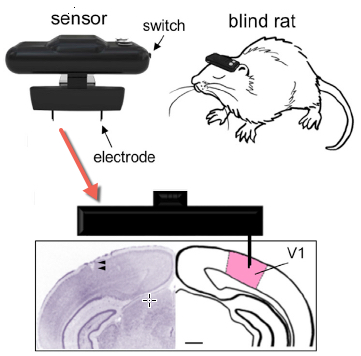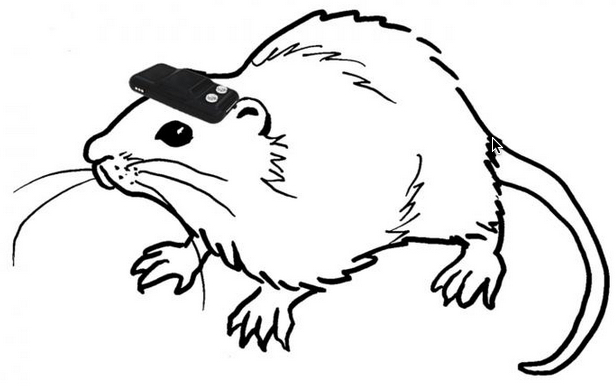Geomagnetic compass hooked to the brain allows blind rats to ‘see’
April 3, 2015
By attaching a microstimulator and geomagnetic compass to the brains of blind rats, researchers found that the animals can spontaneously learn to use new information about their location to navigate through a maze, and nearly as well as normally sighted rats.
The researchers say the findings suggest that a similar kind of neuroprosthesis might also help blind people walk freely through the world.
Most notably, perhaps, the findings, reported in the Cell Press journal Current Biology on Thursday April 2, show the incredible flexibility and latent ability of the mammalian brain, says Yuji Ikegaya of the University of Tokyo.
“We demonstrated that the mammalian brain is flexible even in adulthood — enough to adaptively incorporate a novel, never-experienced, non-inherent modality into the pre-existing information sources.”
In other words, he says, the brains of the animals they studied were ready and willing to “fill in the ‘world’ drawn by the five senses” with a new sensory input.
What Ikegaya and his colleague Hiroaki Norimoto set out to do was to not to restore vision per se, but the blind rats’ allocentric sense — the sense that allows animals and people to recognize the position of their body within the environment. What would happen, the researchers asked, if the animals could “see” a geomagnetic signal? Could that signal fill in for the animals’ lost sight? Would the animals know what to do with the information?

Geomagnetic sensor system, with connection to the primary visual cortex (adapted) (credit: Hiroaki Norimoto and Yuji Ikegaya/Current Biology)
The head-mountable geomagnetic sensor device the researchers devised allowed them to connect a digital compass (the kind you’d find in any smart phone) to two tungsten microelectrodes for stimulating the visual cortex of the brain.
The very lightweight device also allowed the researchers to turn the brain stimulation up or down and included a rechargeable battery. Once attached, the sensor automatically detected the animal’s head direction and generated electrical stimulation pulses indicating which direction they were facing — north or south, for instance.
The “blind” rats were then trained to seek food pellets in a T-shaped or a more complicated maze. Within tens of trials, the researchers report, the animals learned to use the geomagnetic information to solve the mazes.
In fact, their performance levels and navigation strategies were similar to those of normally sighted rats. The animals’ allocentric sense was restored.
“We were surprised that rats can comprehend a new sense that had never been experienced or ‘explained by anybody’ and can learn to use it in behavioral tasks within only two to three days,” Ikegaya says.
New technology for the blind — or everyone?
The findings suggest one very simple application: to attach geomagnetic sensors to the canes used by some blind people to get around. (Or perhaps a new smartphone app could output sound to indicate direction based on the phone’s compass data? The app might also provide GPS-based location cues.)
More broadly, based on the findings, the researchers expect that humans could expand their senses through sensors that detect geomagnetic input, ultraviolet radiation, ultrasound waves, and more. Our brains, it appears, are capable of much more than our limited senses allow.
“Perhaps you do not yet make full use of your brain,” Ikegaya says. “The limitation does not come from your lack of effort, but it does come from the poor sensory organs of your body. The real sensory world must be much more ‘colorful’ than what you are currently experiencing.”
Abstract of Visual Cortical Prosthesis with a Geomagnetic Compass Restores Spatial Navigation in Blind Rats
Allocentric sense is one of the major components that underlie spatial navigation. In blind patients, the difficulty in spatial exploration is attributed, at least partly, to the deficit of absolute direction perception. In support of this notion, we announce that blind adult rats can perform spatial tasks normally when externally provided with real-time feedback of their head directions. Head-mountable microstimulators coupled with a digital geomagnetic compass were bilaterally implanted in the primary visual cortex of adult rats whose eyelids had been sutured. These “blind” rats were trained to seek food pellets in a T-shaped maze or a more complicated maze. Within tens of trials, they learned to manage the geomagnetic information source to solve the mazes. Their performance levels and navigation strategies were similar to those of normal sighted, intact rats. Thus, blind rats can recognize self-location through extrinsically provided stereotactic cues.
